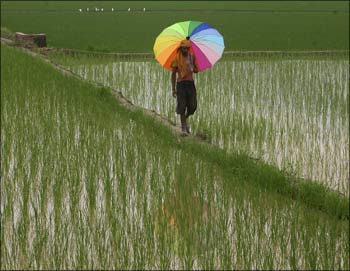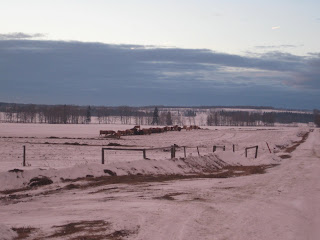Last week I was asked the question of: What's a Steer? Aren't all cows the same?
My response, a gawking look, and the need for total explanation! I realize not everyone is a farm kid, and that learning the ins and outs of the agriculture industry is something that most people don't even come near to mastering! I figured that this would be a post about definitions to give each of you a bit of insight on agriculture! Whether your a city slicker or a country kicker, you better strap on your boots cause this here lesson is gonna give you more knowledge than you bargained for.
 |
| Here's a laugh for your day:) |
Definitions:
Cattle Industry
Cow: The mature FEMALE of a bovine animal
Bull: Mature MALE of the a bovine animal
Heifer: A young FEMALE cow over one year old that has not yet produced a calf
Steer: MALE bovine that is castrated before sexual maturity (Cannot be the sire of a calf)
Heifer Calf: FEMALE baby calf under one year of age
Bull Calf: MALE baby calf, under one year of age
Dairy vs. Beef Cattle:
 Dairy- Dairy cows are bred to produce large quantities of milk, from which dairy products are made. Dairy cattle are often bred for their prominent udder, not muscle capacity. Cows raised for dairy rarely live their 20 year life span, as the average cow is removed from the dairy herd around age four and marketed for beef. Dairy farmers usually begin breeding heifers around 13 months of age. Dairy cow's gestation period is approximately 9 months. Once the newborn calf is on average, three days old, it is removed from its mother and bottle fed milk, this is so that the cow can continue to be milked each day for the profit of the farm. The heifer calves produced are often kept on the farm as replacement milk cows. Bull calves born are either sold at the market as a form of beef or used as breeding bulls later on.
Dairy- Dairy cows are bred to produce large quantities of milk, from which dairy products are made. Dairy cattle are often bred for their prominent udder, not muscle capacity. Cows raised for dairy rarely live their 20 year life span, as the average cow is removed from the dairy herd around age four and marketed for beef. Dairy farmers usually begin breeding heifers around 13 months of age. Dairy cow's gestation period is approximately 9 months. Once the newborn calf is on average, three days old, it is removed from its mother and bottle fed milk, this is so that the cow can continue to be milked each day for the profit of the farm. The heifer calves produced are often kept on the farm as replacement milk cows. Bull calves born are either sold at the market as a form of beef or used as breeding bulls later on.  Beef- Beef cattle are cattle raised for meat production, known as beef. A cow produces a calf after each 9 month gestation period, and this calf is either used in the breeding herd, or sold for beef. There are two separate types of beef cattle farming, commercial and purebred . The commercial cattle industry is when cattle are crossed between various breeds. The purebred cattle industry is when cattle are one specific breed only. Beef cattle can be used not only as a source of beef, but for glue, leather, soap, and certain types of medicine.
Beef- Beef cattle are cattle raised for meat production, known as beef. A cow produces a calf after each 9 month gestation period, and this calf is either used in the breeding herd, or sold for beef. There are two separate types of beef cattle farming, commercial and purebred . The commercial cattle industry is when cattle are crossed between various breeds. The purebred cattle industry is when cattle are one specific breed only. Beef cattle can be used not only as a source of beef, but for glue, leather, soap, and certain types of medicine. The Farming Industry- Farms are important to the world as a we get nearly all the food we eat from them. As the technologies throughout the agriculture industry have expanded, farmers have began to use science to make crops grow faster and produce a higher yield. In order to feed the livestock on the farm, farmers need foods such as Alfalfa, Clover, Hay and Grasses which can all be grown in the field, and grass, on the pasture. Farm livestock are grown so that they make more milk or produce more meat, and old machinery has become new, time and energy-saving machines. Successful farmers need to know about the land, crops, animals, selling the products, managing money, and loaning money when advances are needed for the farm.
Livestock on a Farm- Beef Cattle, Dairy Cattle, Pigs/Hogs, Horses, Sheep, Goats, Poultry, Buffalo, Alpaca, Elk, Deer, etc
Crops on a Farm- Corn, Wheat, Sugar Beets, Nuts, Flowers, Potatoes, Soy Beans, Pineapples, Cotton, Rye, Oats, Barley etc.


Harvesting Season-
For each different type of crop, the time of the year in which the produce is ready to be gathered or taken off the field varies. Different types of machines are needed for each type of crop, and a variety of different procedures and methods are used for each! Since each of these methods would take me forever to discuss with all of you, I decided to pick two that are done on our farm, giving you a bit of insight into my life in late August and early September each year!
- Oats are grown throughout Canada, but the major growing areas are in the western Prairie region.
- Oats are planted in spring, from May to June, and harvested from August to October.
- Most oats are harvested for grain, although in Alberta and British Columbia, around 40 percent of the planted oat area is cut "green," and fed, mainly to cattle, as green chop, hay, or silage.
- On a global scale, Canada is a major oat producer. Fluctuations in Canadian production due to weather can have a significant impact on the world oat supply.
- In May the Oat seed is planted into the soil by an air seeder, throughout the course of its growth, the seed is sprayed with a chemical to kill the weeds and enhance growth rate
- Swathing is done a week prior to harvesting the oats, to let the grains dry and ripen
- A combine is used to take Oats off of the field, and then the yield is stored in a grain bin
Barley-
- Barley is planted in spring, from May to June, and harvested from August to October.
- Most barley is harvested for grain, although in Alberta and British Columbia, around 15 percent of planted barley area is cut "green, and fed, mainly to cattle as green chop, hay, or silage.
- On a global scale, Canada is a major barley producer. Fluctuations in Canadian production due to weather can have a significant effect on world barley supply.
- There are two broad categories of barley varieties: two-row and six-row. Both varieties are used by the malting and livestock feed industries.
- The steps of taking barley off of a field are the exact same as harvesting oats!
Machinery Used in the Production of Oats & Barley-
Air Seeder-An air seeder is an agricultural implement also called a planter or seeder and it is used to plant usually a seed crop in a large field.
| Swather |
Combine-A machine that harvests grain crops, it removes the grains from the straws of crops. The waste straw left behind on the field is the remaining dried stems and leaves of the crop, which is either chopped and spread on the field or baled for feed and bedding for livestock.
Chemical Uses-
Importance of using Chemical Pesticide & Herbicide
Pesticide- Pesticides can save farmer's money by preventing crop losses to insects and other pets
Herbicide- A herbicide, commonly known as a weedkiller, is a type of pesticide used to kill unwanted plants. Selective herbicides kill specific targets while leaving the intended plant healthy and living
That pretty much covers the questions that I have been asked about life on the farm! Stay tuned for the upcoming edition of: What's Silage! As well as many more informative agricultural posts:) Have a great weekend everyone! Please remember if you have any questions, to please ask!
-Jess
































